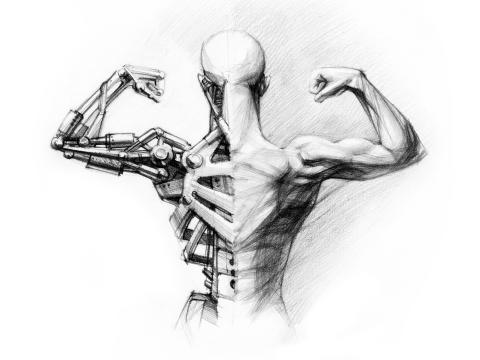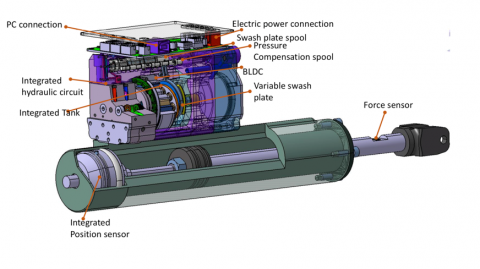
KALYSTA Actuation: giving robots and exoskeletons muscles
The fruit of the SEHA project, under the direction of Samer AlFayad at the Computer Science, Bioinformatics, Complex Systems Laboratory (IBISC – Univ. Paris-Saclay, Univ. d’Évry), the start-up KALYSTA Actuation is taking a fresh approach to hydraulic actuation technology, generally used by machines on construction sites to lift heavy loads: the actuators have been miniaturised, to create robots, prostheses, exoskeletons and even aeroplane seats.
"Not all the devices around us run on electricity," explains Samer AlFayad of the IBISC laboratory. But electric motors are of course the most common. They activate fan blades, make washing machine drums spin, and control remote-controlled toys. "However, a second category of actuators, hydraulic cylinders, generate much greater force and are the preferred choice for excavators or tractors." A hydraulic actuator usually consists of a piston positioned at the end of a cavity which is filled with a petroleum-based oil. To move the arm of the excavator, additional oil is introduced through a small hole, which pushes the piston. This action is based on Pascal's principle: when a force is applied on a small surface of an incompressible oil, a much larger force is generated on the piston, where the contact surface is larger. Ultimately, the cylinder multiplies the force.
Hydraulic and electric no longer at cross-purposes
"Despite its advantages, hydraulic technology is disappearing, especially from university curricula," laments Samer AlFayad. "It generates less enthusiasm and investment. Whereas electric power is a mature technology these days, hydraulics remains a specialist field." Hydraulic technology is difficult to control, especially if there are variations in temperature, and requires large equipment. It is therefore confined to applications where it is essential, such as machines for public construction works or athletic robots for military use. But according to the IBISC researcher, ignoring the potential of hydraulics is a big mistake. In particular, he sees it as an opportunity to develop exoskeletons, motorised structures attached to an individual to enhance their strength and allow them to carry heavy loads. "Although various exoskeletons have been developed on the basis of conventional hydraulic actuation, they have not been that popular, since the user has to attach a pump and various pipes to their back, making the devices much less socially acceptable!" admits Samer AlFayad. Instead, our approach is to combine hydraulic and electric technologies. Drawing on the best of both worlds would result in more powerful and less cumbersome exoskeletons."
Faster, lighter, stronger and safer
The idea of shrinking the hydraulic system emerged from Samer AlFayad's research into humanoid robotics and mechatronics, in which he has been involved for more than 15 years. The development of the compact SEHA (Servo Electro Hydraulic Actuator) module, supported by the SATT Paris-Saclay, is the team's most recent success. The developed module consists of a hydraulic unit and a cylinder with smart controls. "It is no more than about ten centimetres high and boasts one of the best strength-to-volume ratios in the world: it can move a mass of 800 kg at a speed of 20 cm/s." The semi-electric/semi-hydraulic module is the first step in the construction of an exoskeleton or a complete humanoid robot. "This actuator is small enough to be integrated into an exoskeleton, at the level of a joint. Thanks to its force compensation system, the SEHA is capable of handling unexpected shocks and making sure the interaction between the robot and its user is safe". The performance of the module, compared to that of current hydraulic robots, is highly promising: "By using our technology, the weight of a robot could be halved, while its price could be reduced and its working life extended," enthuses Samer AlFayad.
Since the launch of the KALYSTA Actuation start-up from the project in 2019, the team has managed to weather the fallout from the Covid-19 pandemic and has successfully commercialised its first units. In 2021, KALYSTA Actuation won the WAI (We Are Innovation) Paribas campaign, which resulted in a collaboration with the industrial firm Poclain Hydraulics.
Stimulating the interest of the next generation
"Our first customers were universities, since we offer them the possibility to democratise hydraulic actuation," explains Samer AlFayad. The system wins customers over thanks to its easy-to-use interface, intuitive handling and a price that is much lower than currently available technologies. "Within the 2nd year's Master's Mechatronics, Machine Vision and Artificial Intelligence (MMVAI) programme, we offer students practical training in hydraulics, to remove any apprehension they may have for this technology, and to train the next generation of scientists. Hydraulics is no longer in vogue in universities. Nevertheless, industry will always need systems that generate large forces."
Transforming medicine, aviation and robotics
As automation expands into more and more areas, the SEHA system promises a whole host of applications. While more than a thousand children are the victims of landmines every year, few of them have access to motorised prostheses, which would allow them to regain greater mobility. The SEHA system would therefore offer a low-cost and safe solution for operating the joints of these prostheses. "A motorised prosthesis needs to adapt the generated force to the young person's age, to accompany them throughout their period of growth. But electric motors are expensive for the time being, and need be continually replaced as the user grows. With a hydraulic component, just changing the pressure applied would be sufficient, without having to change the motor." A system like this would be more adaptable and scalable.
Another promising application for the SEHA is in aviation. "These days, a first-class seat on an aeroplane contains seven motors on average. Integrating the hydraulic technology will remove seven kilos from each seat, a major benefit in an industry where weight savings are crucial," adds Samer AlFayad. Finally, the researcher has not overlooked his main research subject in the IBISC laboratory: he also specialises in the development of dynamic humanoid robots.
References:
- Samer AlFayad, Mohamad Kardofaki, Maya Sleiman. Hydraulic actuator with overpressure compensation (WO2020173933A1). World Intellectual Property Organization (WIPO). 2020
- Samer Alfayad, Fethi B. Ouezdou, Faycal Namoun, Gordon Gheng. High performance integrated electro-hydraulic actuator for robotics – Part I: Principle, prototype design and first experiments. Sensors and Actuators A: Physical, Volume 169, Issue 1, 2011, Pages 115-123, ISSN 0924-4247

